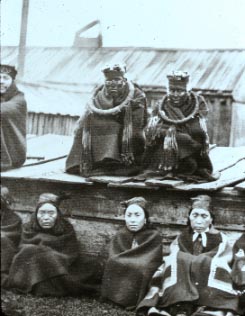
The materials on this page are intended for use by students enrolled in ANTH 329 North American Indians. This page and its references are periodically up-dated.
 |
| Hamatsa |
Reading Assignments
Gill 1982: 72-73 and 124-129, and review 114-138
Oswalt and Neely 1999:249-289
Overview
The primary focus of this section will be on the Tlingit of Alaska and the Northwest Coast culture area. Additional references will also be made to the Quileute and Tsimshian peoples. The Kwakuitl are also a well-known people of the area.
The Northwest Coast culture area extends along some 2,000 miles of coastline from the Alaskan Panhandle in the north to the northern tip of California in the south.
The Northwest Coastal peoples, such as the Haida, Kwakiutl, Tlingit and Tsimshian, are known for their richly developed symmetrical and stylized art forms, represented in the dance masks and totem poles, their stratified and ranked social order of nobles, commoners and slaves, and an intricate pattern of give-aways, known as the "potlatch." The aesthetic and religious expression researched its fullest expression during the "winter ceremonials." Members of the secret societies, such as the Kwakuiult Hamatsa (Cannibal Spirit), would re-enact the oral traditions, wearing colorful masks and performing elaborate dances. Living in wood-planked housing in sedentary villages, the Northwest Coastal peoples subsisted on an abundance of salmon fishing and traveled on the waterways in ocean-going dugout canoes.
Key Concepts and Terms
Study Guide Questions
You are currently viewing http://www.uidaho.edu/~rfrey/coastal1.htm
To return to Frey's Home Page
To return to the Department of Sociology,
Anthropology and Justice Studies
To return to the University of Idaho Home Page
Page manager:rfrey@uidaho.edu